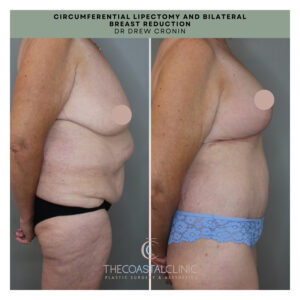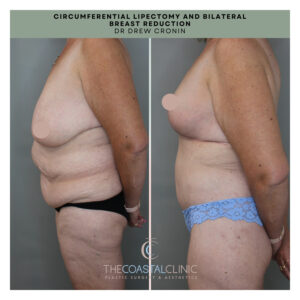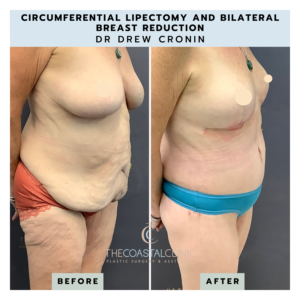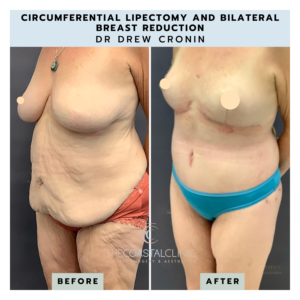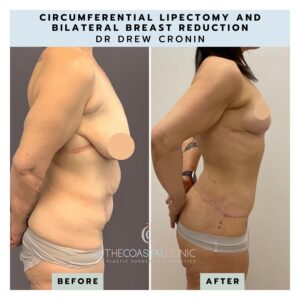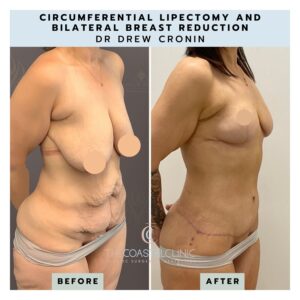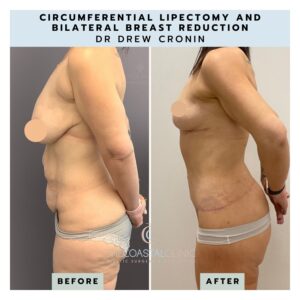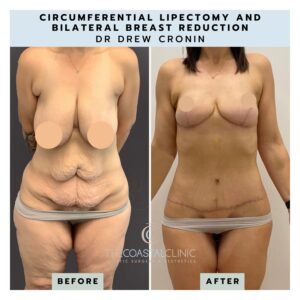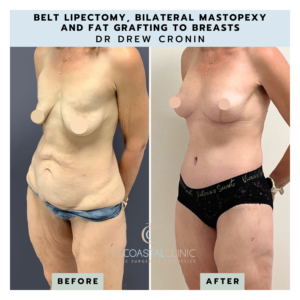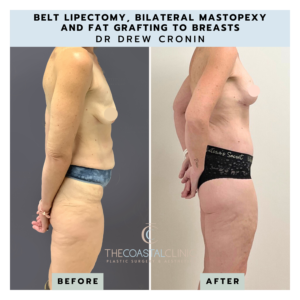
Circumferential/Belt Lipectomy (Body Lift)
A belt lipectomy, also known as a circumferential body lift, is a surgical procedure designed to remove excess skin and fat from the midsection of the body, encompassing the abdomen, hips, lower back, and buttocks.
This procedure is typically sought by individuals who have experienced significant weight loss or have excess skin due to ageing. By addressing multiple areas simultaneously, a belt lipectomy provides comprehensive body contouring, resulting in a smoother and firmer appearance. The surgery involves a continuous incision around the waist, allowing the surgeon to lift and tighten the underlying tissues for enhanced body shape and improved overall aesthetic.
Who is a good candidate for a belt lipectomy (body lift)?



A good candidate for a body lift is someone who meets the following criteria:
Significant Weight Loss
Stable Weight
Good Health
Realistic Expectations
Commitment to a Healthy Lifestyle
Emotional Readiness
Circumferential/Belt Lipectomy (Body Lift): The Procedure
How is a belt lipectomy performed?
A belt lipectomy, also known as a circumferential body lift, is a comprehensive surgical procedure designed to remove excess skin and fat from the midsection of the body, including the abdomen, hips, lower back, and buttocks. Here is an overview of how the procedure is typically performed:
Anaesthesia
The patient is placed under general anaesthesia at Pindara Private Hospital.
Incision
A continuous incision is made around the lower torso, resembling a belt, hence the name “belt lipectomy.” The incision typically runs circumferentially around the waistline, encompassing the abdomen, hips, and lower back.
Tissue Removal and Contouring
Excess skin and fat are carefully removed from the designated areas. If it has been discussed, Dr Cronin may also perform liposuction.
Muscle Tightening
In most cases, the underlying abdominal muscles are tightened to enhance the overall contour and firmness of the midsection. This step is similar to an abdominoplasty (tummy tuck).
Repositioning of Tissues
The remaining skin is repositioned and pulled tight to create a smoother contour. The surgeon meticulously ensures that the skin is evenly distributed.
Closure of Incisions
The incisions are closed with three layers of absorbable sutures. Drains are placed under the skin to remove excess fluid and reduce swelling.
Hospital stay
The patient is monitored in a recovery area and then typically will stay in hospital for between 4 and 6 nights depending on the extent of the surgery and the patient’s overall health. The patient will be placed in a post-operative garment which is to be worn for at least 6 weeks.
Recovery & Aftercare
You will usually be discharged home from hospital the same day. You are required to have someone pick you up from the hospital and remain with you for the first 24hours. You will be placed in a surgical bra which is to be worn at all times for the first 6weeks. Surgical garments provide compression to the site and assist in reducing swelling and support healing.
Recovery from a belt lipectomy can take several weeks. Patients are advised to avoid strenuous activities and follow their surgeon’s instructions closely to ensure optimal healing and results. It’s important to keep in mind that you will have significant swelling, bruising and tightness in the skin. Often patient’s experience a slight hunch until the swelling subsides and the incision has had time to heal.
Post-operative pain is managed with prescribed medications to ensure comfort during recovery.
You will have an initial review with our nurse within the first of being discharged from the hospital, and at each week until your incisions are healed and your pain has resolved. Drains are typically removed by the end of the first week. Occasionally the drains may be required to stay in for longer. 6 weeks post-operatively you will have a review with Dr Cronin. Regular follow -ups with Dr Cronin at 3months, 6 months and 12months are also essential to monitor your surgical outcome.
Patients are advised to limit physical activities and avoid strenuous exercises for several weeks post-surgery. Light walking is encouraged to promote circulation, but heavy lifting and intense activities should be avoided until cleared by the surgeon. Generally you can return to driving a car around 2-3weeks.
Proper scar care is essential for optimal healing. Patients are advised on proper scar care techniques to minimise scarring. We offer a scar treatment plan for all surgical patients. Keeping the incision site clean and protected from sun exposure is crucial.
Final results of a belt lipectomy can be seen after several months, once swelling has completely subsided and tissues have settled. Patients can expect a flatter, firmer abdominal contour, with continued improvement over the first year post-surgery.



What are the benefits of a body lift?
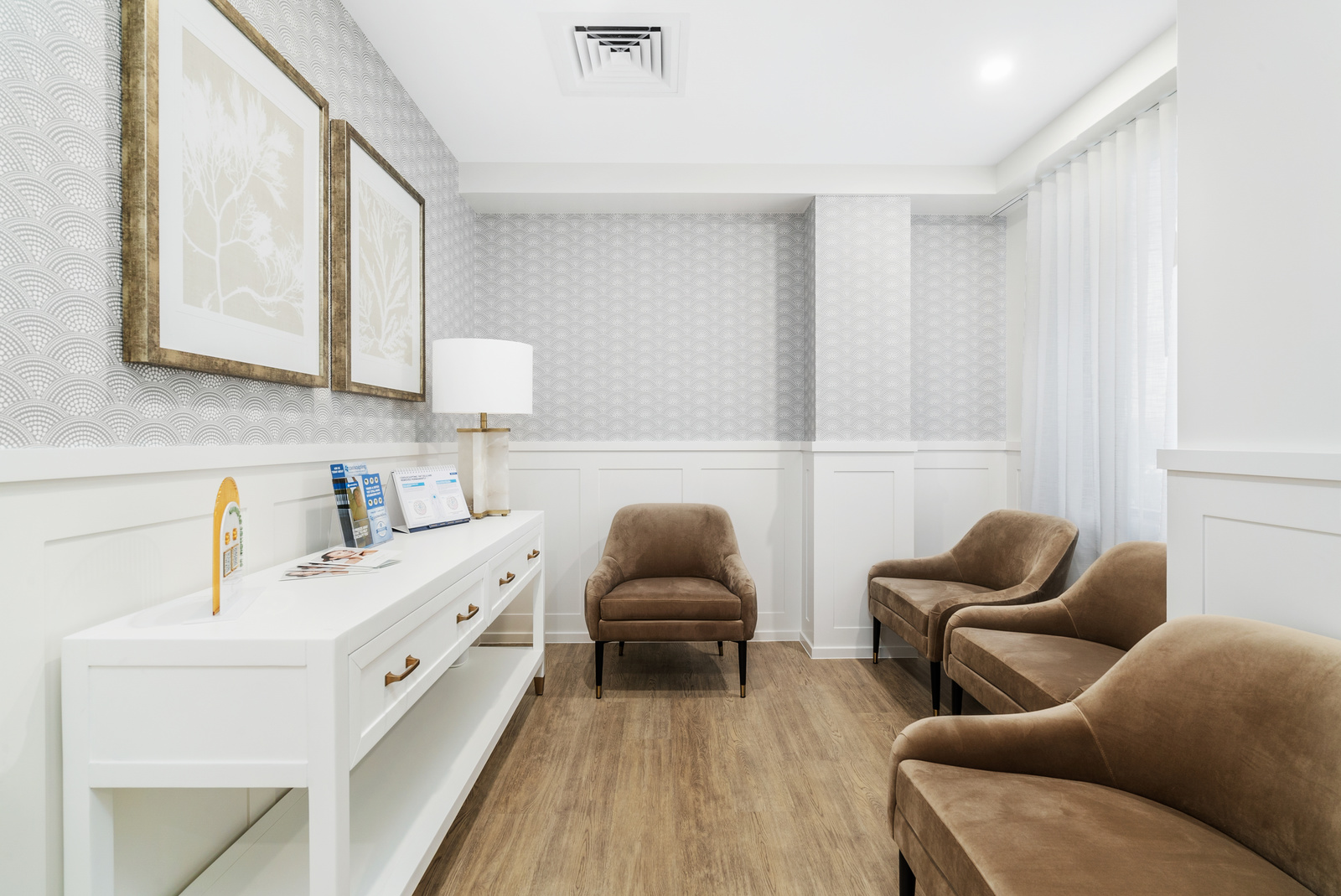

Improved Body Contour
Improved Mobility and Comfort
Reduction of Skin Irritation and Infections
Long-Lasting Results
Belt Lipectomy Before and After Gallery
Individual results will vary from patient to patient and according to factors including genetics, age, diet, exercise. All invasive surgery carries risk and requires a recovery period and care regime. Be sure you do your research and seek a second opinion from an appropriately qualified Specialist Plastic Surgeon before proceeding. Any details are general in nature and are not intended to be medical advice or constitute a doctor-patient relationship.
For comprehensive information on the potential risks and post-surgery recovery process, please see risks associated with surgery section towards the bottom of this page.
Frequently Asked Questions
If we haven’t addressed your inquiries yet, here are some frequently asked questions that may provide the information you’re looking for. However, if you still have any remaining questions or concerns, please don’t hesitate to reach out to our clinic at 07 5683 0820 or via email at admin@thecoastalclinic.com.au. Our team is ready to assist you.
The decision to undergo breast augmentation after a history of breast cancer should be made on an individual basis in consultation with your oncologist and a certified plastic surgeon such as Dr Drew Cronin with experience with breast reconstruction. There are several factors to consider, including the type and stage of breast cancer.
Most patients can return to their normal daily activities, including work, after about 4-6 weeks. However, it’s important to note that more strenuous activities, such as heavy lifting or vigorous exercise, should still be avoided for a longer period, as advised by your surgeon.
It can take several months for the swelling to fully subside, and the final results of the procedure to become apparent. During this time, you should continue to follow your surgeon’s post-operative instructions and attend any scheduled follow-up appointments.
Diet
A healthy diet can assist in the recovery process. Eat a well-balanced diet rich in fruits, vegetables, lean protein, and whole grains to support your body’s healing capabilities and always stay hydrated.
Smoking
If you smoke, it is strongly recommended to quit smoking several weeks before the surgery. Smoking can negatively impact the healing process and increase the risk of complications.
Support in the home
During the initial phase of recovery, you may require assistance with daily activities, particularly if you have small children or dependents. Arrange for a responsible adult to help you with household chores, childcare, or transportation during the early days after surgery.
You will also need someone to drive you home and assist you during the initial recovery period. It is a requirement during the first 24hours after your surgery that someone is present at home with you.
Stay active
Regular exercise can help improve your overall fitness and assist in the recovery process.
Tummy tuck or abdominoplasty surgery specifically targets excess skin in the front area of the abdominal region, whereas, for patients that have excess skin on the front and back of the abdominal region, a circumferential or ‘belt’ lipectomy may be more appropriate.
In most cases, Medicare rebates may be accessed for circumferential lipectomy surgery if the circumferential excess of redundant skin and fat interferes with the activities of daily living. During your consultation with Dr Cronin, it will be determined if your surgery is deemed medically necessary.
For more information please refer to Medicare Benefits Schedule – Item 30177
If you have private health insurance, it is important to contact your provider directly to discuss your eligibility.
A detailed will be provided after your consultation with Dr Cronin detailing the costs for the surgical fees, any device, implant and garments used during your procedure and estimated hospital fees. We will provide you with the contact details for the anaesthetist who will provide you with a separate quote for your surgery.
The cost of your procedure includes:
- Dr Cronin’s surgical fees
- Hospital fees (estimate only) If you have private health insurance this will only be the cost of your excess.
- Two surgical garments
- All post-operative appointments with our Nurse
- All post-operative follow up appointments with Dr Cronin
- Two LED Heallite sessions at The Coastal Clinic Aesthetics located at Varsity Lakes
- A 6 week post operative pack which includes the Strataderm
The timeline for when it is safe to drive after a body lift procedure varies based on individual recovery rates and the specifics of the surgery.
Patients are typically advised to avoid driving for at least 2 to 3 weeks after surgery. This period allows for initial healing and reduces the risk of complications.
If you are taking prescription pain medications, especially those that can impair your ability to operate a vehicle, you should not drive. These medications can affect your reaction time and judgment.
During your consultation with Dr Cronin he will
There are three types of breast implant surfaces available.:
Smooth breast implants have a smooth, non-textured surface. They move feely within the breast pocket and feel very soft. However they have been found to have a higher risk of capsular contracture and rupture.
Nano-textured implants have a very fine, uniform texture created using advanced manufacturing techniques. They are most commonly used by Dr Cronin as the fine texture promotes better tissue integration, helping to stabilise the implant and reduce the likelihood of movement or rotation. There is also a reduced risk of capsular contracture compared to smooth implants.
Textured– Micro textured breast implants have a more pronounced and rougher surface which improves the stability of the implant. Micro-textured implants have also been shown to reduce capsular contracture compared to smooth breast implants. Macro textured implants are no longer available in Australia.
During your consultation with Dr Cronin, he will suggest the most appropriate implant type for you.
During a belt lipectomy the incisions are typically made around the waistline, extending from the lower abdomen to the back. The incisions are strategically placed to allow for removal of excess skin and fat and to tighten the underlying muscles. The resulting scars will be permanent, but their appearance can improve over time.
Certified Plastic Surgeon Dr Drew Cronin takes care to limit scar length and placement in the least conspicuous position possible. Nonetheless, scars may be more noticeable than you anticipated. It is important that you have realistic expectations of the surgery and that you discuss potential outcomes with your surgeon. You should be mindful that, even following good healing and good surgical results, visible and prominent scarring can develop.
Initially, the scars may appear red, raised, and more visible. However, with proper care and the natural healing process, scars tend to fade and flatten over time. It can take several months to a year or more for the scars to mature and become less noticeable.
You will be offered to add on an optional Scar treatment plan as part of your surgery which has been designed to assist in the treatment of scarring.
Dr Cronin strongly recommends that patients have up-to-date private health insurance before undergoing a body lift. If you are covered for a body lift, private health insurance ensures that your hospital stay and care are covered. This coverage helps avoid out-of-pocket expenses in the event that you need to return to the operating theatre or require an extended hospital stay.
Yes, patients in Australia may be able to access their superannuation to pay for a circumferential lipectomy if it is deemed medically necessary. The process involves applying for the early release of superannuation on compassionate grounds through the Australian Taxation Office (ATO). Here’s how to do it:
Process to Access Superannuation for Medically Necessary Surgery
Medical Assessment:
Obtain a letter from your treating specialist or surgeon that outlines the medical necessity of the circumferential lipectomy. This letter should explain why the procedure is required and how it will address your medical condition.
Gather Supporting Documents:
You will need to provide supporting documentation, including a detailed quote for the surgery and any related medical costs. This quote should be from the medical professional or hospital where the procedure will be performed.
Submit an Application to the ATO:
Apply for early release of superannuation on compassionate grounds via the myGov website. You will need to link your myGov account to the ATO and complete the application form online.
Include all required supporting documents, such as the medical assessment letter and the surgery quote.
Wait for Approval:
The ATO will review your application and make a decision. This process may take several weeks. They may contact you for additional information if needed.
Access Funds:
If your application is approved, the ATO will issue a release authority to your superannuation fund. Your super fund will then release the approved amount to you.
Pay for Surgery:
Once you have received the funds, you can use them to pay for your circumferential lipectomy and any associated medical costs.
Important Considerations
Ensure all information provided is accurate and complete to avoid delays in the processing of your application.
Be aware that accessing superannuation early can impact your retirement savings, so consider this option carefully and seek financial advice if needed.
Check with your superannuation fund for any specific requirements or additional forms they may need.
Consulting with your healthcare provider and possibly a financial advisor can help ensure you understand the process and implications of accessing your superannuation for medical purposes.
Combining these procedures can be advantageous in terms of recovery time and cost, but it significantly increases the complexity and duration of the surgery. Surgeons carefully assess each patient to determine the safest and most effective combination of procedures.
During your consultation, Dr Cronin may recommend combining multiple procedures into a single operation, but the exact number and type of procedures depend on the patient’s overall health, the extent of the surgery, and safety considerations. While there is no strict cutoff for the maximum safe duration under general anaesthesia, most elective procedures aim to stay within the 6 to 8-hour window.
Other procedures that may be combined with a body lift include as mastopexy, breast reduction, thigh lift, bra lift or brachioplasty.
Yes you will need a GP referral before your consult with Dr Cronin.
If your procedure is deemed medically necessary and has an item number, to qualify for the medicare rebate, it is a requirement to get a referral from your GP to Dr Cronin and send it through to our clinic email admin@thecoastalclinic.com.au prior to your consult with Dr Cronin.
A body lift with Dr Cronin will take between 4-6hours depending on the complexity of the surgery and if any other procedures have been added.
Risks of Surgery
As part of our commitment to delivering exceptional patient care, we aim to provide you with comprehensive information regarding the general risks associated with surgical procedures, anaesthesia, and procedure-specific risks.
- Acute medical event: Heart or lung complications (e.g. heart attack, stroke, chest infection)
- Death
- Deep Vein Thrombosis (DVT) or Pulmonary Embolisms (PE)
- A sore throat/breathing difficulty due to the general aesthetic or the endotracheal tube, which can cause swelling, noisy breathing or discomfort
- Short-term nausea following general anaesthesia
- Wound infection, which may result in treatment with antibiotics or further treatment/surgery. This is more likely in a smoker or a person with diabetes.
- Heavy bleeding from the wound, which may result in further treatment/surgery
- Wound discharge
- Poor or slow healing of the skin; wound breakdown; skin necrosis
- Wound dehiscence (wound ruptures along the surgical incision)
- Bruising and swelling. This will start to subside in one to two weeks but can take up to several months to settle
- Abscess/Haematoma/Seroma/Oedema
- Pain and discomfort
- Allergic reaction to sutures, dressing, antiseptic solutions
- Altered or loss of sensation in and around the treated area, which may persist for some months, numbness maybe permanent
- Adverse scarring
- Revisionary surgery
- Psychological impact of change in appearance
- Unsatisfactory cosmetic appearance
- Seroma
- Haematoma
- Prologned drain duration or reinsertion
- Wound necrosis
- Parathesia (may be numbness or tingling)
- Asymmetrical scarring
- Acute medical event: Heart or lung complications (e.g. heart attack, stroke, chest infection)
- Death
- Deep Vein Thrombosis (DVT) or Pulmonary Embolisms (PE)
- A sore throat/breathing difficulty due to the general aesthetic or the endotracheal tube, which can cause swelling, noisy breathing or discomfort
- Short-term nausea following general anaesthesia
- Wound infection, which may result in treatment with antibiotics or further treatment/surgery. This is more likely in a smoker or a person with diabetes.
- Heavy bleeding from the wound, which may result in further treatment/surgery
- Wound discharge
- Poor or slow healing of the skin; wound breakdown; skin necrosis
- Wound dehiscence (wound ruptures along the surgical incision)
- Bruising and swelling. This will start to subside in one to two weeks but can take up to several months to settle
- Abscess/Haematoma/Seroma/Oedema
- Pain and discomfort
- Allergic reaction to sutures, dressing, antiseptic solutions
- Altered or loss of sensation in and around the treated area, which may persist for some months, numbness maybe permanent
- Adverse scarring
- Revisionary surgery
- Psychological impact of change in appearance
- Unsatisfactory cosmetic appearance




